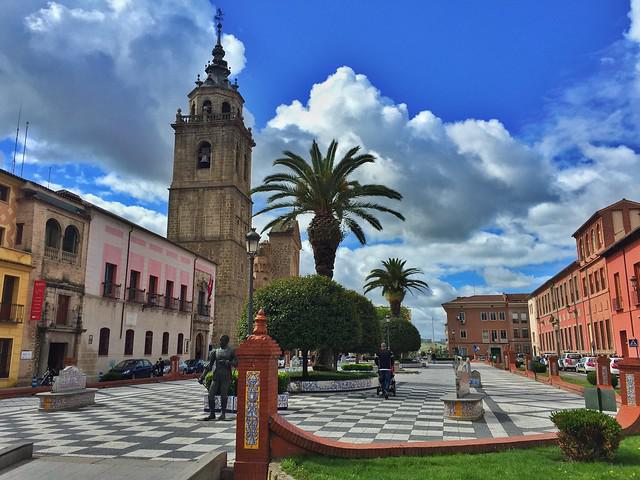What to see in Talavera de la Reina: 9 essential places
The great unknown of the Tagus
Yasmina JiménezText Hugo PalottoPhotographyIn this article
- 1. A square with a lot of crumb
- 2. Its four bridges and the Tagus
- 3. City of pottery
- 4. Watchtowers, what are they?
- 6. Parks with a lot of grass
- 7. The Sistine Chapel of Ceramics
- 8. Stories and legends
- 9. Where to eat and tapas
see more
January 11, 2022Talavera de la Reina (Toledo) has long had a luxury international ambassador, the actress Gwyneth Paltrow, who is also an honorary citizen of the city; and another native of these lands who does not fall short, the chef Carlos Maldonado. Added to this was the tourist backing that came with the declaration of Ceramics as Intangible Cultural Heritage by UNESCO. However, Talavera is much more than all this. At the foot of the Tagus, the city is full of mysteries and curiosities, and of a historical heritage that invites at least two long days of visits and walks.
"It's as if she had been asleep and now she woke up." With this sentence, the Talavera tourist guide, Helena Rueda, summarizes the situation of the city with regard to tourism. And the truth is that there are many activities to do, places to discover, pottery to buy, restaurants to eat in and a region full of unparalleled nature. Repsol Guide gives you some guidelines, with the help of Helena, so you know what to visit through the essentials of the city, so you don't miss anything if you decide to come here.
# 1. A square with a lot of crumb1. A square with a lot of crumb
The Plaza del Pan continues to be one of the nerve centers of the city where civil, political and religious power converge. The essence of Talavera congregates in this square where there is everything from a plaque that commemorates the famous Juan Ruiz de Luna, the one who returned Talavera to ceramic splendor at the beginning of the 20th century, to a statue of Fernando de Rojas (yes, the author of La Celestina), who was also a city councilman.
Very close to the Tagus River, in this square we find the origin of the city in what was the Hospital de la Misericordia (today a cultural center), one of the oldest hospitals in Castile because it was where the pilgrims on their way to Guadalupe stopped. "It has a very nice Renaissance patio and you can visit it," says Helena before explaining that this square is called the square of bread because in the 16th century there was a Calahorra that gave this food to the poorest in times of scarcity.
There is the town hall, a Renaissance palace, and the famous Collegiate Church, which is actually the Church of Santa María la Mayor, ceased to be a Collegiate Church since the mid-19th century. Some palm trees finish giving a special touch to this symbolic space of the city.
# 2. Its four bridges and the Tagus2. Its four bridges and the Tagus
The river has defined Talavera as only the great rivers that cross the cities know how to do. It was the natural border that separated Muslim from Christian Spain for more than a couple of centuries. "There are four bridges and these represent the changes in Talavera and its progress," says the tour guide.
The Reina Sofía Bridge, known as the Iron Bridge, is 426 meters long and was inaugurated in 1908. The Industrial Revolution had opted for iron as a construction material, a fact that materialized in many constructions during the late 18th century and early twentieth century. But here in Talavera, which only had one bridge to cross the river and was forced to use boats every time it collapsed, it was a milestone for the city. With this work they improved communication with the Jara region, Extremadura and Andalusia. An essential, especially if you want to show off your photo on social networks.
Another of the most emblematic bridges in the city is the Roman, "which is actually medieval", according to Helena, and the confusion comes from the fact that there was an ancient Roman one, on which the current one was founded, which was carried away by the current . When they did it, already in the Middle Ages, this part of the river resisted having a passageway and has always had many problems. "That's why we call it the Patchwork Bridge", laughs the guide who is already revealing how the Talaverans like to put their own names to places without caring about the official one. In front of this bridge there is a hidden treasure: an island, where there is a kiosk that opens on weekends and that Talaveranos visit to snack and have a drink.
The third bridge would be the one that was built in the 70s with the sole intention of allowing cars to cross to the other region. And, finally, the Castilla-La Mancha Bridge, with 52 stay cables, was inaugurated in 2011. The spectacular nature of this bridge lies in its 192-metre height, which makes it the tallest in Spain.
Beyond the bridges, in the last 25 years there has been a change in Talavera that has allowed the river to take advantage of, at least, its views and the freshness it generates in the walks that have been carried out along its shore and that people enjoy as a recreational space. Of course, one of the best views of the city is precisely next to the Roman Bridge, with the river behind and the San Jerónimo convent in front.
# 3. City of pottery
3. City of pottery
That Unesco has had its eye on Talavera ceramics does not come from anything. "In Talavera there has always been ceramics, we even know the name of a Roman potter: Calvinus", Helena begins to delve into one of her favorite topics in the city, so much so that she was on the commission that presented ceramics to UNESCO as a candidate for Intangible Cultural Heritage. “Although there were also Arab kilns, the important thing came with Felipe II, who decided to make El Escorial with ceramic baseboards and had Juan Flores, a good ceramist from northern Europe, brought to Talavera, who settled here and that was when the so-called Renaissance ceramics”, continues the tourist guide. What the king started doing was imitated by all the nobility. And that is how Talavera pottery flourished during the Golden Age. With the Bourbons came decadence, as they preferred French porcelain.
At the beginning of the 20th century, when there are only two workshops left in the city, Juan Ruiz de Luna appears, who associated with Enrique Guijo and in September 1908 they inaugurated their ceramic workshop, Nuestra Señora del Prado. “They were inspired by those pieces from the Golden Age and it becomes a boom again. They begin to hold exhibitions and win a prize in Madrid”, says Helena. They were followed by others and ceramic orders came from many parts of the world: Angola; Santa Fe or Rosario in Argentina; or Havana, among many other places.
Until the crisis of the 90s arrived and, again, everything began to decline. However, with the UNESCO declaration, Talavera is experiencing a resurgence and can be seen in its ceramic centers, where works continue to travel around the world. You cannot visit the city without going through its best-known workshops and taking some of its jewels.
To learn more about the history of ceramics, there is the Ruiz de Luna Museum. And, although the entire city is an open-air exhibition of its beautiful tiles with blue as the predominant color, there is also a mural route. The first to be built is that of the San Jerónimo Association and is located near the river. It is a tribute to the fishermen of the Tagus, in which one day is seen from sunrise to sunset, with the different types of fishing (rod, net or boat) that were practiced in the river and the four fish species. "It was made when the last fisherman on the Tagus died," explains the guide.
# 4. Watch towers, what are they?4. Watchtowers, what are they?
Tourist visits in Talavera usually start where the letters of the city are written with ceramic tiles, but also from where you have an incredible view of the albarrana towers and the walled district, the undisputed symbol of the city. But what are watchtowers?
Helena says that it is “a perpendicular structure that comes out to defend the wall. They are Christian and they went up through a door to another that was on top, from where they could scan the entire horizon and allowed them to throw stones -or whatever- to defend themselves". Its name comes from Arabic and means advanced tower. In Talavera, they were hidden among the architecture of the city and when they were excavated they appeared. To the luck of the Talaveranos and the visitors.
5. A bracelet with a lot of potential
Tourist bracelets have become fashionable in some cities, giving the possibility of visiting more places for less money. In the case of Talavera, this bracelet, which depends on the Archbishopric, costs 7 euros and helps maintain heritage, which would otherwise be difficult. Mayte Pino, the coordinator of the initiative, is very proud of the four churches that can be visited thanks to this service. Despite the fact that it was beginning to take off just when the pandemic broke out, Mayte is confident that it will now work well again because “Talavera is the great unknown. Not even I, who am from here, knew what can be taught and what remains to be brought to light”.
With the bracelet you have free access – as many times as you want for at least two days – to “the Church of Santiago El Nuevo, a Mudejar reference and where its 18th century organ stands out; the Prado Basilica; the Church of San Andrés and the jewel in the crown: the Colegial”, explains Mayte, which for her looks a lot like the Cathedral of Plasencia. "When you enter you are shocked to see a church like this in Talavera." Be careful, because you can only enter this one with the bracelet and it has a surprise: with it you can access the flamboyant Gothic rose window that crowns this beauty. “You go up a spiral staircase made of stone and the curious thing about this rose window is that it is separated from the stained glass window. There is a large chamber that allows you to touch the stained glass window on one side and the rose window on the other. Then you can take a walk among the 15th century flying buttresses”. A marvel that Mayte boasts about.
Helena reveals a detail for tourists: the rose window is illuminated at night and it is a sight to see at that time. “Made of templated brick stucco it is very similar to that of Guadalupe. There are those who believe that it could have the same authorship, ”underlines the guide while she looks at him dazzled from below.
# 6. Parks with a lot of grass6. Parks with a lot of grass
The Prado Gardens are the oldest in the city. "It already appears on maps at the beginning of the 19th century," says the tourist guide. Here we find the Fuente de las Ranas, the work of Ruiz de Luna and Francisco Arroyo, the Casa de los Patos, the Bandstand of Music, among other surprises worked with ceramics worthy of the best images to remember the city. “It is a kind of María Luisa Park (the one in Seville), but in miniature”, concludes Helena. And right there, you can also find the Plaza de Toros from 1890, where the famous bullfighter Joselito died.
Very close is the Parque de la Alameda, which "was built where the old cattle market of Talavera was, one of the most important in Spain", explains the guide about the other great green lung of the city and with great success among its visitors. population. Nothing remains of that prosperous market that generated so much wealth in Talavera, except the May and September fairs that were born with livestock. However, the lakes, the bridges that cross them and the trees of the Alameda are a guarantee of a good afternoon stroll.
#7. The Sistine Chapel of Ceramics7. The Sistine Chapel of Ceramics
The Basilica of the Virgin of Our Lady of the Prado, located at the end of the Prado Gardens, could have been a temple dedicated to Ceres, goddess of agriculture, in Roman times. "In Christian times it became a hermitage to the Virgen del Prado (patron saint of the city), where we have a small image of her, probably from the 12th century, very small, 50 centimeters," says Helena, indicating the size with the hands. Of course, small but with many cloaks: "The oldest is that of the Catholic Monarchs, which is in the museum."
It is known as the Sistine Chapel of Ceramics because, enlarged several times, it exhibits an excellent collection of murals made with the city's tiles. “The one with the portico is from the 16th century; once inside, we have the life of the virgin in tiles, since she was born, her childhood, her mother, she with a child fleeing from Egypt... It is a very original iconography because after the Council of Trent these types of images were changed and It is not usual to see them”, the tourist guide proudly emphasizes, explaining that they are from the 17th century, although many were restored by Ruiz del Luna. To the left of the basilica, the genealogy of Christ according to the Gospel of Saint Matthew; further on the pulpits, one antique and the other by Ruiz de Luna; and the altarpiece of San Antón from the 16th century, would close the ceramic works of the church. At least inside. Outside the exhibition continues. A marvel!
# 8. Stories and legends8. Stories and legends
For a time, it was suspected that the La Celestina orchard could really be in Talavera and not in Salamanca, because Fernando de Rojas spent a large part of his life in the city of Toledo. Discarded this mystery, the end of the writer continues to surprise: “When they found her remains, they divided them. A part of the bones went to La Puebla de Montalbán, the place of her birth; and another part, for Talavera”, says Helena.
Another curiosity that this city hides is why it belongs to the Queen. King Alfonso XI gave it to his wife, María de Portugal, as a wedding dowry. However, and despite what he presaged such a beautiful gift, the monarch was in love with Leonor de Guzmán, whom he chose as her favorite and with whom he had more than a dozen children. When the king died, Leonor was unprotected, she lost all her privileges until, finally, Maria of Portugal ordered her assassinated in the city's Alcazar. Little by little, and after such violent and sad events, Talavera finally ended as a gift to the Archbishopric and became an archiepiscopal town.
TAPAS BARS IN TALAVERA DE LA REINA (TOLEDO)Tapas in the fashionable places of the old town of Talavera
# 9. Where to eat and tapas9. Where to eat and tapas
Talavera has a luxury ambassador, chef Carlos Maldonado, who after winning MasterChef is recognized throughout the gastronomic world at a national level. The chef not only advertises the culinary history of the area, but has also valued Talavera crafts, such as its ceramics, for example, among other things. His restaurant 'Raíces' is highly recommended (1 Sol Guía Repsol).
Tapas is another of the great activities that can be enjoyed in the city, especially now in the old part of the city where the fashionable bars have been filled with Soletes.
Tags: Natural attractions / Carlos Maldonado / Castilla-La Mancha / Chefs / Where to eat / Where to go / Spain / Gastronomy / Municipalities / Museums / Tourist plans / Toledo Province / What to see / Roots (Talavera de la Reina) / Restaurants / Rivers / Talavera de la Reina / Tourism / Urban tourism /In this article
- 1. A square with a lot of crumb
- 2. Its four bridges and the Tagus
- 3. City of pottery
- 4. Watchtowers, what are they?
- 6. Parks with a lot of grass
- 7. The Sistine Chapel of Ceramics
- 8. Stories and legends
- 9. Where to eat and tapas
see more







![47 best antiage nutritive cream in 2022 [based on 326 reviews] 47 best antiage nutritive cream in 2022 [based on 326 reviews]](https://website-google-hk.oss-cn-hongkong.aliyuncs.com/drawing/article_results_6/2022/2/27/1918fc37c66ad30564173e69d9df88a0.jpeg)
